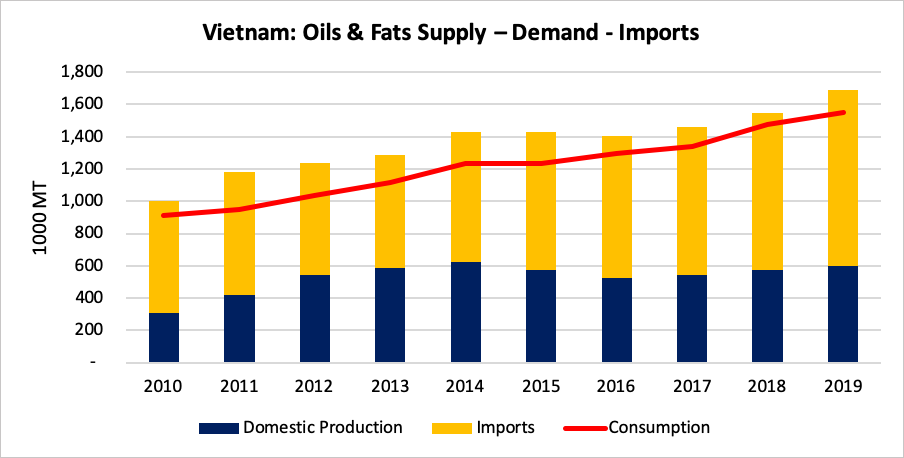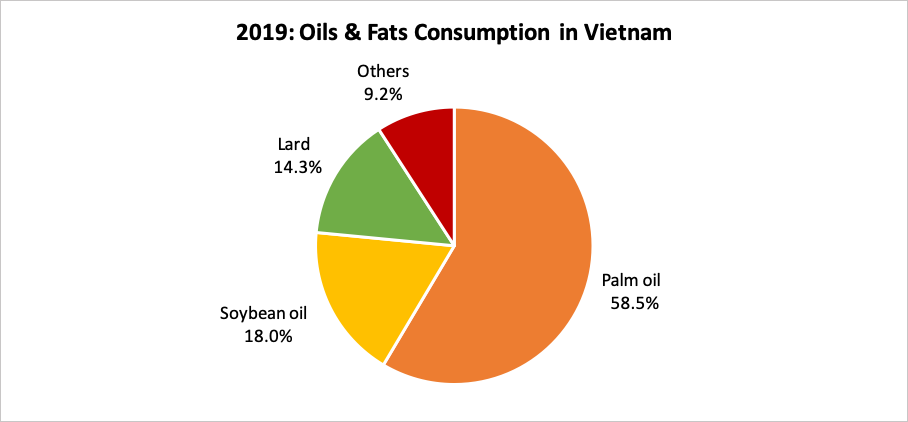Vietnam is the second-largest importer of Malaysian palm oil in the ASEAN region. In 2019, the country imported 1.09 million MT of oils and fats, out of which palm oil was the major imported oil with a share of 87% (947,000 MT). Soybean oil and lard are the most produced oils and fats in Vietnam with a share of 74% from their total indigenous oils and fats production. The demand for soybean oil is being influenced by the demand for feed from the local livestock industry. While lard is one of the main sources of oils and fats especially in the rural areas.

Vietnam is heavily dependent on import. In average for the past five years, 68.9% of oils and fats consumption in Vietnam was met by import. The consumption of oils and fats is driven by growth in the food and beverage sector. The sector has experienced strong growth due to growth in GDP, rising per capita income, rapid urbanization and growing middle-class consumers.

Palm oil is the most consumed edible oil in Vietnam with a share of 58.5% from total oils and fats consumption. Palm oil is mainly being used in the household, HORECA sector and food processing industries. It is estimated that the Vietnamese food service market will reach USD 65.03 billion by 2024 compared to USD 39.74 billion in 2019, CAGR of 13.05%. The growth of the food industry in this sector has spurred the demand for palm oil.
| Malaysian Palm Oil Export to Vietnam (MT) | ||||
|---|---|---|---|---|
| Product | Jan-May 2020 | Jan-May 2019 | Change (MT) | Change (%) |
| RBD Palm Olein | 142,891 | 177,385 | (34,493) | (19.45) |
| RBD Palm Oil | 46,746 | 47,192 | (447) | (0.95) |
| RBD Palm Stearin | 17,071 | 13,028 | 4,042 | 31.03 |
| Others | 1,089 | 853 | 236 | 27.70 |
| Total | 207,796 | 238,458 | (30,662) | (12.86) |
Source: MPOB
During the period January to May 2020, Malaysian palm oil exports to Vietnam have registered a decline of 30,662 MT or 12.86% compared to the same period in 2019. This is mainly due to the increase in palm oil import from Indonesia and high import of soybean from the USA. It is reported for the period January to April 2020, Indonesian palm oil import in Vietnam increased by 18,000 MT or 16.82% to 125,000 MT compared to the same period in 2019 due to the competitive price offered by Indonesia.
Also, Vietnam is currently recovering from the 2019 African Swine Fever (ASF) outbreak and as a result, it is anticipated there will be an increase in soybean domestic crushing activities. For this year, it is estimated the soybean import will increase to cater to the demand for domestic feed requirements which will also increase the availability of soybean oil in the market for consumption. This will translate into slow palm oil imports in Vietnam.
For the year 2020, it is anticipated that the Malaysian palm oil export to Vietnam will drop by 10% to 20% due to high soybean oil production and competition from Indonesian palm oil.
Prepared by: Rina Mariati
*Disclaimer: This document has been prepared based on information from sources believed to be reliable but we do not make any representations as to its accuracy. This document is for information only and opinion expressed may be subject to change without notice and we will not accept any responsibility and shall not be held responsible for any loss or damage arising from or in respect of any use or misuse or reliance on the contents. We reserve our right to delete or edit any information on this site at any time at our absolute discretion without giving any prior notice.

